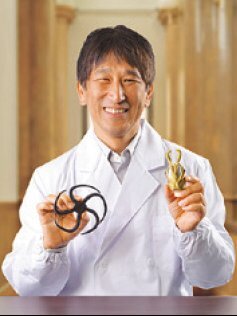Hitoshi Aonuma, Ph.D.
Professor, Division of Biomolecular Organization, Molecular Physiology
Research Interests
Animals alter their behavior to respond to the demands of changing circumstances. We have investigated the design principle of neuronal mechanisms underlying adaptive behavior including social adaptability in animals. We focus on how animals decide their behavior depending on their circumstance and previous experiences. Aggressive behavior in insects provides great model systems to investigate the neuronal mechanisms underlying emerging adaptive behaviors. We focus on insects and some kinds of invertebrate animals to investigate neuronal mechanisms of adaptive behavior since they have relatively simple and identical nervous systems. From comparative neurophysiological research, we deepen our understanding of the adaptive behavior of animals, which helps us to develop biology and biological-inspired technical innovations.
Research Focus
1. Neuronal mechanisms underlying aggressive behavior and escape behavior of animals
2. Biomechanics of ultra-fast movements of insects
3. Effects of electromagnetic field on insect nervous systems
Recent Publications
- Aonuma H., and Benelli, G. (2023)
Aminergic control of aggressive behavior in social insects.
Entomologia Generalis 43, 927-937.
- Aonuma H., Naniwa, K., Sugimoto, Y., Ohkawara, K. and Kagaya K. (2023)
Embodied latch mechanism of the mandible to power at ultra-high speed in the trap-jaw ant Odontomachus kuroiwae.
J. Exp. Biol. 226 (10) jeb245396.
- Naniwa, K. and Aonuma H. (2021)
Descending and ascending signals that maintain rhythmic walking pattern in the cricket.
Front. Robot. AI , 8:625094.
- Owaki D., Aonuma H., Sugimoto Y. and Ishiguro A. (2021)
Leg amputation modifies coordinated activation of the middle leg muscles in the cricket Gryllus bimaculatus.
Scientific Reports, 11: 1327.
- Aonuma H. (2020)
Serotonergic control in initiating defensive responses to unexpected tactile stimuli in the trap-jaw ant Odontomachus kuroiwae.
J. Exp. Biol. 223: jeb228874.
- Saito K., Pérez-de la Fuente R., Arimoto K., Seong YA., Aonuma H., Niiyama N and You Z. (2020)
Earwig fan designing: biomimetic and evolutionary biology applications.
Proc Natl Acad Sci USA 117(30): 17622-17626.
- Aonuma H., Mezheritskiy M., Boldyshev B., Totani Y., Vorontsov D., Zakharov I.S., Ito E. and Dyakonova V. (2020)
The role of serotonin in the influence of intense locomotion on the behavior under uncertainty in the mollusk Lymnaea stagnalis.
Front. Physiol. 11:221.
- Wakita D., Kagaya K. and Aonuma H. (2019)
A general model of locomotion of brittle stars with a variable number of arms.
Roy. Soc. Interface 17:162.
- Wakita D, Hayase Y and Aonuma H. (2019)
Different synchrony in rhythmic movement caused by morphological difference between five- and six-armed brittle stars.
Scientific Reports 9: 8298.
- Naniwa K., Sugimoto Y., Osuka K. and Aonuma H. (2019)
Defecation initiates walking in the cricket Gryllus bimaculatus.
J. Insect Physiol. 112: 117-122.
Contact
Office: Building C, room 602, (lab: room 601)
Tel: +81-78-803-5718
Fax: +81-78-803-5718
E-mail: aon@sapphire.kobe-u.ac.jp
 JAPANESE
JAPANESE 